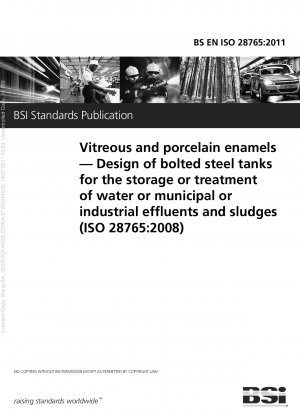BS EN ISO 28765:2011
Vitreous and porcelain enamels. Design of bolted steel tanks for the storage or treatment of water or municipal or industrial effluents and sludges
- Standard No.
- BS EN ISO 28765:2011
- Release Date
- 2011
- Published By
- British Standards Institution (BSI)
- Status
- Replace By
- BS EN ISO 28765:2016
- Latest
- BS EN ISO 28765:2022
- Replace
- BS EN 15282:2007
- Scope
- This International Standard establishes the requirements for the design and use of vitreous-enamel-coated bolted cylindrical steel tanks for the storage or treatment of water or municipal or industrial effluents and sludges. It applies to the design of the tank and any associated roof and gives guidance on the requirements for the design of the foundation. It applies where a) the tank is cylindrical and is mounted on a load-bearing base substantially at or above ground level; b) the product of the tank diameter in metres and the wall height in metres lies within the range 5 to 500; c) the tank diameter does not exceed 100 m and the total wall height does not exceed 50 m; d) the stored material has the characteristics of a liquid, exerting a negligible frictional force on the tank wall; the stored material may be undergoing treatment as part of a municipal or industrial effluent treatment process; e) the internal pressure in the headspace above the liquid does not exceed 50 kPa and the internal partial vacuum above the liquid does not exceed 10 kPa; f) the walls of the tank are vertical; g) the floor of the tank is substantially flat at its intersection with the wall; the floor of the tank may have a rise or fall built in to allow complete emptying of the tank contents, the slope of which does not exceed 1:100; h) there is negligible inertial and impact load due to tank filling; i) the minimum thickness of the tank shell is 1,5 mm; j) the material used for the manufacture of the steel sheets is carbon steel (tanks constructed of sheets made from aluminium or stainless steel are outside the scope of this International Standard); k) the temperature of the tank wall during operation is within the range −50 °C to +100 °C under all operating conditions. This International Standard also gives details of procedures to be followed during installation on site and for inspection and maintenance of the installed tank. It does not apply to chemical-reaction vessels. It does not apply to tanks fitted with floating roofs. It does not cover resistance to fire.
BS EN ISO 28765:2011 Referenced Document
- EN 101 Ceramic Tiles - Determination of Scratch Hardness of Surface According to Mohs
- EN 10209:1996 Cold-Rolled Low Carbon Steel Flat Products for Vitreous Enamelling - Technical Delivery Conditions
- EN 14430:2004 Vitreous and porcelain enamels - High voltage test
- EN 1993-1-6 Eurocode 3 - Design of steel structures - Part 1-6: Strength and Stability of Shell Structures*, 2017-04-26 Update
- EN 1993-4-1 Eurocode 3 - Design of steel structures - Part 4-1: Silos
- EN 1993-4-2 Eurocode 3 - Design of steel structures - Part 4-2: Tanks*, 2016-08-01 Update
- EN 1998-4 Eurocode 8 - Design of structures for earthquake resistance - Part 4: Silos, tanks and pipelines
- ISO 15686-1 Buildings and constructed assets - Service life planning - Part 1: General principles and framework*, 2011-05-15 Update
- ISO 2178 Non-magnetic coatings on magnetic substrates - Measurement of coating thickness - Magnetic method*, 2016-03-01 Update
- ISO 2747 Vitreous and porcelain enamels - Enamelled cooking utensils - Determination of resistance to thermal shock
- ISO 2859-1 Sampling procedures for inspection by attributes - Part 1: Sampling schemes indexed by acceptance quality limit (AQL) for lot-by-lot inspection; Technical Corrigendum 1
- ISO 28706-1:2008 Vitreous and porcelain enamels - Determination of resistance to chemical corrosion - Part 1: Determination of resistance to chemical corrosion by acids at room temperature
- ISO 28706-2:2008 Vitreous and porcelain enamels - Determination of resistance to chemical corrosion - Part 2: Determination of resistance to chemical corrosion by boiling acids, boiling neutral liquids and/or their vapours
- ISO 28706-3:2008 Vitreous and porcelain enamels - Determination of resistance to chemical corrosion - Part 3: Determination of resistance to chemical corrosion by alkaline liquids using a hexagonal vessel
- ISO 28706-4:2008 Vitreous and porcelain enamels - Determination of resistance to chemical corrosion - Part 4: Determination of resistance to chemical corrosion by alkaline liquids using a cylindrical vessel
- ISO 4532 Vitreous and porcelain enamels; determination of the resistance of enamelled articles to impact; pistol test
- ISO 6370-2 Vitreous and porcelain enamels — Determination of the resistance to abrasion — Part 2: Loss in mass after sub-surface abrasion*, 2020-02-10 Update
- ISO 8289:2000 Vitreous and porcelain enamels - Low voltage test for detecting and locating defects
BS EN ISO 28765:2011 history
- 2022 BS EN ISO 28765:2022 Vitreous and porcelain enamels. Design of bolted steel tanks for the storage or treatment of water or municipal or industrial effluents and sludges
- 2016 BS EN ISO 28765:2016 Vitreous and porcelain enamels. Design of bolted steel tanks for the storage or treatment of water or municipal or industrial effluents and sludges
- 2011 BS EN ISO 28765:2011 Vitreous and porcelain enamels. Design of bolted steel tanks for the storage or treatment of water or municipal or industrial effluents and sludges
- 2007 BS EN 15282:2007 Vitreous and porcelain enamels. Design of bolted steel tanks for the storage or treatment of water or municipal or industrial effluents and sludges
BS EN ISO 28765:2011 Vitreous and porcelain enamels. Design of bolted steel tanks for the storage or treatment of water or municipal or industrial effluents and sludges has been changed from BS EN 15282:2007 Vitreous and porcelain enamels. Design of bolted steel tanks for the storage or treatment of water or municipal or industrial effluents and sludges.
